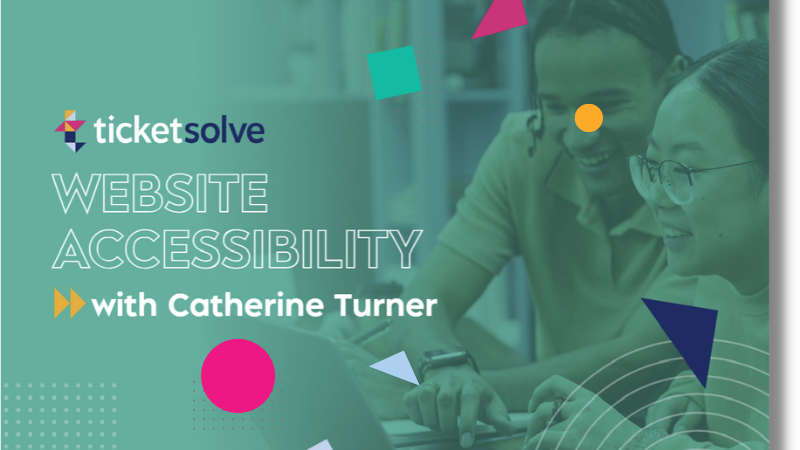Ticketsolve Guide: Website Accessibility with Catherine Turner

Web accessibility is a critical aspect of modern website design, ensuring that everyone, including people with disabilities, can easily access and navigate online content. Catherine Turner's insightful blog post, Accessible Website Design, sheds light on the importance of accessibility and offers valuable advice for designing inclusive websites. In this blog, we will explore the key takeaways from our whitepaper with Catherine and discuss how they can help you create accessible, user-friendly customer journeys.
The Importance of Accessible Website Design
This guide highlights the importance of accessible website design in ensuring equal access to digital content for all users. With the internet playing a crucial role in our daily lives, it is essential to make digital content available to everyone, regardless of their physical or cognitive abilities. By implementing accessible design principles, businesses can reach a wider audience, improve user experience, and adhere to legal requirements in various jurisdictions.
Understanding the Web Content Accessibility Guidelines (WCAG)
The WCAG is a set of guidelines developed by the World Wide Web Consortium (W3C) to help website designers and developers create accessible content. Turner's blog emphasises the need to understand and follow these guidelines, which are organised under four main principles: perceivable, operable, understandable, and robust. By adhering to these principles, designers can ensure that their websites cater to the needs of users with diverse abilities.
Perceivable Content
Working closely with Catherine, she stresses the importance of making content perceivable by providing text alternatives for non-text content, such as images and multimedia. This includes adding alt text to images and providing transcripts for audio and video content. Additionally, Catherine suggests using adequate contrast between text and background colours, as well as resizable text to improve readability for users with visual impairments.
Operable Interfaces
An operable interface is crucial for users with mobility impairments or those using alternative input devices. Turner's blog highlights the need to make all website functionality available through a keyboard, ensuring that interactive elements can be easily accessed and navigated. She also underscores the importance of providing clear and consistent navigation and offering mechanisms to bypass repetitive content.
Understandable Content and Interface
Turner's blog emphasises that content and interface should be understandable to users with cognitive impairments or learning disabilities. This can be achieved by using clear and concise language, providing meaningful headings and labels, and organising content logically and predictably. The guide also suggests offering help and guidance, such as tooltips or contextual help, to assist users in completing tasks or understanding complex information.
Robust Design
A robust website design can be reliably interpreted by a wide range of user agents, including assistive technologies. Catherine highlights the importance of using proper HTML mark-up, following semantic conventions (a shared use of language), and ensuring compatibility with various browsers and devices. This helps ensure that users with assistive technologies, such as screen readers, can successfully navigate and interact with your website.
Our new whitepaper on accessible website design offers invaluable guidance for creating inclusive, user-friendly websites that cater to diverse user needs. By understanding and implementing the principles of the WCAG, designers can create digital content that is perceivable, operable, understandable, and robust. These efforts not only benefit users with disabilities but also improve overall user experience and extend your website's reach to a broader audience. Grab your copy today!
Categories
Recent posts
Archive
- April 2025 (5)
- March 2025 (5)
- February 2025 (4)
- January 2025 (5)
- December 2024 (3)
- November 2024 (5)
- October 2024 (4)
- September 2024 (7)
- August 2024 (5)
- July 2024 (3)
- June 2024 (3)
- May 2024 (4)
- April 2024 (3)
- March 2024 (4)
- February 2024 (5)
- January 2024 (3)
- December 2023 (3)
- November 2023 (4)
- October 2023 (4)
- September 2023 (5)
- August 2023 (3)
- July 2023 (4)
- June 2023 (4)
- May 2023 (5)
- April 2023 (4)
- March 2023 (4)
- February 2023 (5)
- January 2023 (4)
- December 2022 (4)
- November 2022 (3)
- October 2022 (4)
- September 2022 (5)
- August 2022 (2)
- July 2022 (4)
- June 2022 (5)
- May 2022 (4)
- April 2022 (5)
- March 2022 (3)
- February 2022 (4)
- January 2022 (4)
- December 2021 (2)
- November 2021 (3)
- October 2021 (5)
- September 2021 (4)
- August 2021 (4)
- July 2021 (3)
- June 2021 (4)
- May 2021 (2)
- April 2021 (4)
- March 2021 (5)
- February 2021 (4)
- January 2021 (5)
- December 2020 (4)
- November 2020 (4)
- October 2020 (5)
- September 2020 (5)
- August 2020 (4)
- July 2020 (7)
- June 2020 (5)
- May 2020 (5)
- April 2020 (5)
- March 2020 (8)
- February 2020 (4)
- January 2020 (5)
- December 2019 (3)
- November 2019 (5)
- October 2019 (4)
- September 2019 (4)
- August 2019 (5)
- July 2019 (4)
- June 2019 (4)
- May 2019 (5)
- April 2019 (4)
- March 2019 (4)
- February 2019 (3)
- January 2019 (5)
- December 2018 (4)
- November 2018 (8)
- October 2018 (2)
- September 2018 (3)
- August 2018 (5)
- July 2018 (4)
- June 2018 (4)
- May 2018 (1)
- April 2018 (1)
- March 2018 (3)
- February 2018 (2)
- December 2017 (2)
- November 2017 (3)
- October 2017 (4)
- September 2017 (2)
- August 2017 (1)
- July 2017 (5)
- June 2017 (3)
- May 2017 (2)
- April 2017 (3)
- March 2017 (2)
- February 2017 (3)
- January 2017 (3)
- December 2016 (4)
- November 2016 (1)
- September 2016 (1)
- July 2016 (3)
- June 2016 (1)
- May 2016 (2)
- April 2016 (2)
- February 2016 (1)
- January 2016 (3)
- December 2015 (2)
- September 2015 (1)
- August 2015 (2)
- July 2015 (1)
- June 2015 (2)
- May 2015 (2)
- April 2015 (5)
- March 2015 (2)
- February 2015 (2)
- January 2015 (4)
- December 2014 (3)
- November 2014 (3)
- October 2014 (2)
- September 2014 (3)
- August 2014 (3)
- July 2014 (3)
- June 2014 (7)
- May 2014 (6)
- April 2014 (3)
- March 2014 (2)
- February 2014 (1)
- January 2014 (3)
- December 2013 (1)
- August 2013 (1)
- June 2013 (1)
- April 2013 (1)
Sign up for regular updates



%20(1600%20%C3%97%20900%20px).png?width=492&height=277&name=Untitled%20(1600%20%C3%97%20400%20px)%20(1600%20%C3%97%20900%20px).png)

%20(1).png?width=578&height=325&name=Untitled%20(Twitter%20Post)%20(1).png)